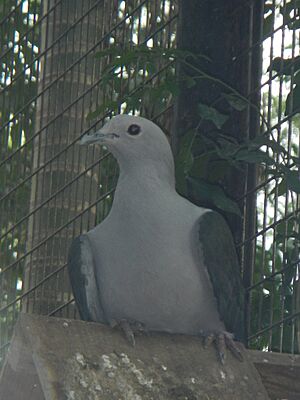Grey imperial pigeon facts for kids
Quick facts for kids Grey imperial pigeon |
|
|---|---|
 |
|
| Conservation status | |
| Scientific classification | |
| Genus: |
Ducula
|
| Species: |
pickeringii
|
The grey imperial pigeon (Ducula pickeringii) is a beautiful bird that lives in parts of Southeast Asia. It's a type of large pigeon found on islands like the Sulu Archipelago, Miangas and Talaud Islands. This pigeon prefers to live in warm, wet forests and even on plantations. Sadly, its home is shrinking, which means it's a vulnerable bird, meaning it needs our help to survive.
Contents
What Does the Grey Imperial Pigeon Look Like?
This pigeon is a large bird with a very smooth and elegant look. It has a pearly grey color on its belly. Its wings, back, and tail are a darker grey. Sometimes, in good light, these parts can even look a bit shiny or iridescent green.
You might also notice a faint white ring around its eyes. It can sometimes be confused with the Green Imperial-Pigeon. However, the Grey Imperial Pigeon has much duller and darker wings. It usually lives in forests on islands far from the mainland. You'll often see it alone or in pairs, high up in the trees. Its song is a deep, booming sound that sounds like "coOOOooouh."
These pigeons like to eat fruits. They have been seen feeding on figs and fruits from Cananga trees.
Where Does the Grey Imperial Pigeon Live?
The grey imperial pigeon's natural habitat includes tropical moist lowland forests. It also lives in both primary (old, untouched) and secondary forest (forest that has regrown). You can also find it in areas with trees that people have planted.
Scientists don't know much about how far these birds travel. Some reports say they stay in one place on certain islands near Borneo. But they definitely move between islands in the Philippines. Their numbers also changed a lot on Karakelang, Indonesia, between 1995 and 1997. Like other birds that specialize in living on small islands, they probably fly around to find enough food.
Why Is the Grey Imperial Pigeon in Danger?
The IUCN Red List has listed this bird as vulnerable. This means it faces a high risk of becoming extinct in the wild. Experts believe there are only about 1,500 to 7,000 adult birds left.
The biggest danger to the grey imperial pigeon is the loss of its habitat. This happens for several reasons:
- Logging: Trees are cut down, both legally and illegally.
- Farming: Forests are cleared to make space for farms.
- City Growth: Land is developed for buildings and tourism.
Because these pigeons are quite large, hunters also target them. They are hunted both for food and to be kept as pets.
How Can We Help the Grey Imperial Pigeon?
There are several ways people are trying to protect the grey imperial pigeon:
- Protected Areas: The bird lives in a few safe places. These include the Turtle Islands National Park, Tunku Abdul Rahman National Park, Maratuas, and Pulau Mantanani Bird Sanctuary. It also benefits from protection on Rasa Island, where it lives alongside the Philippine cockatoo.
- Research: Scientists want to study the birds in their homes. This will help them understand how many birds there are and how they live. This information can help refine population estimates.
- New Protected Areas: They want to suggest more islands or places to become strictly protected areas.
- Removing Threats: On protected islands, efforts are made to remove animals like macaques and black rats. These animals can harm the pigeons or their eggs.
- Awareness Campaigns: People are creating campaigns to teach local communities about conservation. This helps control hunting and stop trees from being cut down on important islands.
- Banning Trade: There is a push to ban the buying and selling of imperial pigeons.


